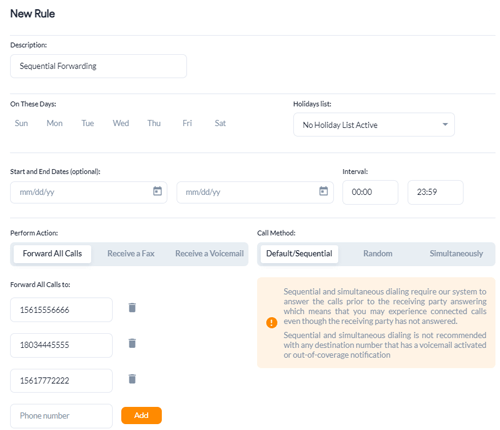What Is Sequential Forwarding?
Sequential Forwarding, also known as sequential ringing, is an efficient system used to deliver a call down a list of predetermined phone numbers if the first number doesn’t answer it. The benefit of sequential forwarding is the assurance that every call is acknowledged and answered. If an attendant is already on the phone or away from their desk, the call is simply forwarded to the next available attendant. This helps to minimize the ratio of unanswered calls.

How Does Sequential Forwarding Work?
First, the call is forwarded to the first (main) preset number which rings for a certain number of seconds (you set the desired length). If there is no answer within that time, the call is automatically redirected down the sequence to the second preset phone number. If the second number does not answer, the call is again forwarded and so on. Up to 4 numbers can be added to the sequence. If the call is never answered you have the option to send it to voicemail.
How to Get Sequential Ringing to Your Virtual Number?
Sequential ringing is an included free feature with virtual numbers from Global Call Forwarding. After your number is activated, you can set up all of the necessary details for using sequential ring through the control panel after logging into your account.
Using Sequential Forwarding from Global Call Forwarding
When using the sequential forwarding feature from Global Call Forwarding, you have the ability to register as many as four back-up ring-to phone numbers per line, arranged in the specific sequential order you would prefer the calls to be answered in.
All incoming calls are then directed, in sequence, to these listed ring-to numbers in the order specified, in the event your main number is not answering or happens to be tending to another call. Efficiency is the force behind the service; during the time the caller waits for the call to be answered, the forwarding service automatically kicks in to find an attendant.
All the while, the caller will be encouraged to wait, as a greeting with an audio menu is heard, ensuring they remain engaged. This audio menu may loop a few times as the ringing process finds a person to answer the call because the sequential forwarding will run through the sequence of trying all of the numbers that have been arranged. In the event the system runs through all the numbers in the sequence with no answer, at that time, the call will get forwarded to voicemail and prompted to leave a message.
One instance sequential forwarding makes the most sense for is in the event you have a large company that operates with different branches in various locations throughout the world.
Organizing a large volume of calls and managing different time zones is much more easily handled with sequential forwarding.
Sequential forwarding, however, is not just for enterprise companies. In the event you are a small business owner running things primarily on your own, sequential forwarding can present many benefits as well. Using sequential ringing can allow you to take calls wherever you are, and calls can be forwarded to multiple phone lines, including office lines, mobile lines, and your home phone line in the specific sequence you need. This allows you to save time and potentially endure fewer instances of missed calls, which may be highly beneficial to your company.
You also have the option to configure the system to set the number of times each line will ring before the call gets forwarded to the next number in the sequence.



